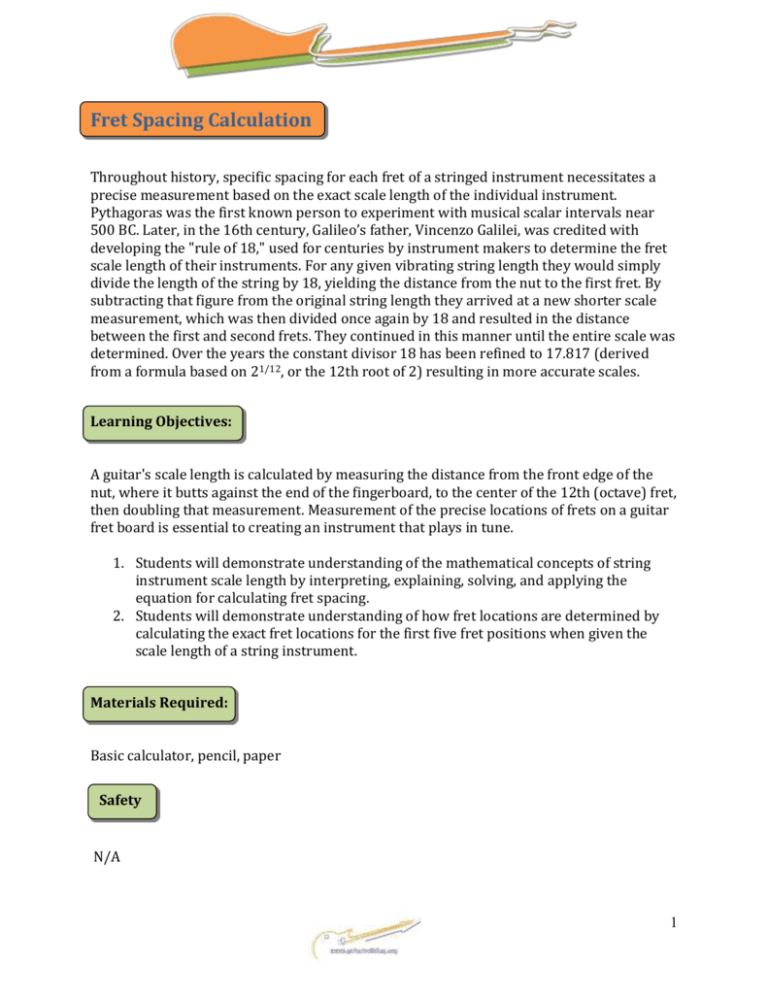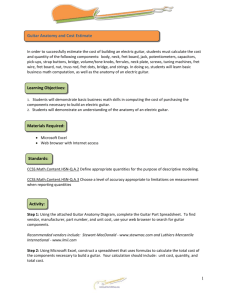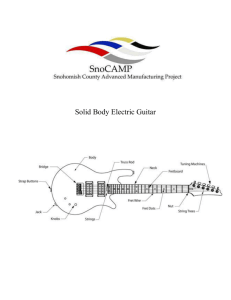Fret Spacing Calculation: Guitar Scale Length & Math
advertisement

Fret Spacing Calculation Throughout history, specific spacing for each fret of a stringed instrument necessitates a precise measurement based on the exact scale length of the individual instrument. Pythagoras was the first known person to experiment with musical scalar intervals near 500 BC. Later, in the 16th century, Galileo’s father, Vincenzo Galilei, was credited with developing the "rule of 18," used for centuries by instrument makers to determine the fret scale length of their instruments. For any given vibrating string length they would simply divide the length of the string by 18, yielding the distance from the nut to the first fret. By subtracting that figure from the original string length they arrived at a new shorter scale measurement, which was then divided once again by 18 and resulted in the distance between the first and second frets. They continued in this manner until the entire scale was determined. Over the years the constant divisor 18 has been refined to 17.817 (derived from a formula based on 21/12, or the 12th root of 2) resulting in more accurate scales. Learning Objectives: A guitar's scale length is calculated by measuring the distance from the front edge of the nut, where it butts against the end of the fingerboard, to the center of the 12th (octave) fret, then doubling that measurement. Measurement of the precise locations of frets on a guitar fret board is essential to creating an instrument that plays in tune. 1. Students will demonstrate understanding of the mathematical concepts of string instrument scale length by interpreting, explaining, solving, and applying the equation for calculating fret spacing. 2. Students will demonstrate understanding of how fret locations are determined by calculating the exact fret locations for the first five fret positions when given the scale length of a string instrument. Materials Required: Basic calculator, pencil, paper Safety : N/A 1 References: Common Core State Standards Initiative. (2012). Mathematics>home>mathematics. Retrieved 5 January 2014 from http://www.corestandards.org/Math Donald Duck in Mathmagicland. (1959). [ You Tube video excerpt]. Disney Motion Pictures. Retrieved from http://youtu.be/iEVGQKwKeCc French, Mark. (2012). Math and music. [You Tube video]. Retrieved from http://youtu.be/0raHDoTIGps French, Mark. (2012). Music and scales. Brain Waves.avi. [You Tube video]. Retrieved from http://youtu.be/AcFEoFvLEWU Huvard, A. J. (1997). Formula for computing a fret scale. Retrieved 5 January 2014 from http://www.cybozone.com/luthier/instruments/fretscale.html Passy. (2012). Guitar mathematics. [Website]. Retrieved from http://passyworldofmathematics.com/guitar-mathematics/ Stewart-Macdonald. (2014). Scale length explained. Retrieved 5 January 2014 from http://www.stewmac.com/freeinfo/Fretting/a-scalelength.html Standards: Common Core State Standards for Mathematics aligned with this activity: CCSS.Math.Content.HSA-SSE.A.1b Interpret complicated expressions by viewing one or more of their parts as a single entity. For example, interpret P (1+r)n as the product of P and a factor not depending on P. CCSS.Math.Content.HSA-SSE.B.3c Use the properties of exponents to transform expressions for exponential functions. For example the expression 1.15t can be rewritten as (1.151/12)12t ≈ 1.01212t to reveal the approximate equivalent monthly interest rate if the annual rate is 15%. CCSS.Math.Content.HSA-REI.A.1 Explain each step in solving a simple equation as following from the equality of numbers asserted at the previous step, starting from the assumption that the original equation has a solution. CCSS.Math.Content.HSA-REI.B.3 Solve linear equations and inequalities in one variable, including equations with coefficients represented by letters. 2 Pre-Activity Play You Tube Video: Excerpt Donald Duck in Mathmagicland: http://youtu.be/iEVGQKwKeCc Play You Tube Video: Dr. Mark French, Math and Music: http://youtu.be/0raHDoTIGps This video shows a relationship between math and music. Dr. French demonstrates how to find the 12th-root of 2 and how it applies to a standard music scale. This number is much more accurate in calculating fret location on a guitar than the “rule of 18.” Since this method is based on an international standard, every stringed instrument fretboard layout can be calculated accurately. You can use this knowledge to calculate frequencies of notes along a scale or to calculate the spacing between the frets of a guitar. The relationship of Dr. French’s discussion on frequencies and our calculation of fret spacing is based on this mathematical equation and the need to control frequencies to play specific musical notes on a guitar. The mathematic formula to calculate fret spacing using the 12th-root of 2 (The equal-tempered chromatic scale) as the constant: 1 X n L1 n r Or, written on one line: X n = L [1- (1 ÷ r n)] Where: X n is the distance of the fret n to the string nut at the end of the fretboard n is the current fret being calculated L is the scale length r 2(1/ 12) = 1.059463 NOTE: To derive the constant value of 17.817 from the “12th-root of 2” formula, use these steps: Constant 12 2 2 1 12 1.059463 Constant =1.059463−1 Constant = 17.817 3 4 Activity Exercises #1‐5: FenderTM One of the most common scale lengths is the Fender 25-1/2 “guitar scale. Found on Stratocasters®, Telecasters®, and the huge variety of instruments inspired by them as well as the replacement, and custom parts available for them. The 25-1/2" produces a rich, strong, bell-like tone, and defined low-end. *Activity A: Determine the first 5 fret locations for a guitar with a standard 25.5-inch scale length Exercises #6‐10: GibsonTM The Gibson 24-3/4" scale is also very common, but it is also the most confusing of all scale lengths—this is because Gibson has changed the scale length standard over the years. It rarely ever measures out to be exactly 24-3/4 inches! This scale has gradually changed over the past fifty or so years due to changes in production equipment. The approximation that is currently used is 24 ¾” Being shorter than the FenderTM 25-1/2" scale, the GibsonTM 24-3/4" scale has a lower tension and what some might describe as a “warmer” tone. *Activity B: Determine the first 5 fret locations for a guitar with a 24.625 scale length. Formula for Calculating Fret Spacing: Dn = [(L – Dn-1) ÷ 17.817] + Dn-1 Where: L = Scale Length n = Fret Position Dn = Distance from Nut to Current Fret Position (rounded to thousandths place) Dn-1 = Distance from Nut to Previous Fret Position (round to thousandths place) 17.817 = constant for calculating fret positions 12 2 2 1 12 Show all procedural steps: formula, substitution, calculation, and answer (See following page for guided practice on how to calculate using this formula) 5 Examples: Guided Practice Determine the first 3 fret locations for a stringed instrument with a 24” scale length. Formula: Dn = [(L – Dn-1) ÷ 17.817] + Dn-1 Where: L = Scale Length n = Fret Position Dn = Distance from Nut to Current Fret Position (round to thousandths place) Dn-1 = Distance from Nut to Previous Fret Position (round to thousandths place) 17.817 = constant for calculating fret positions 12 2 2 1 12 Fret Spacing Example Calculation for Fret Position #1 L = 24” D1 = unknown variable D 0 = 0” (Position of the Nut) D1 = [(L – D0) ÷ 17.817] + D0 = [(24 + 0) ÷ 17.817] + 0 = [24 ÷ 17.817] ≈ 1.347” Fret Position #2 L = 24” D2 = unknown variable D1 = 1.347” D2 = [(L – D1) ÷ 17.817] + D1 = [(24 – 1.347) ÷ 17.817] + 1.347 = [22.653 ÷ 17.817] + 1.347 = 1.271426166 + 1.347 ≈ 2.618” Fret Position #3 L = 24” D3 = unknown variable D2 = 2.618” D3 = [(L – D2) ÷ 17.817] + D2 = [(24 – 2.618) ÷ 17.817] + 2.618 = [21.382 ÷ 17.817] + 2.618 = 1.200089802 + 2.618 ≈ 3.818” 6 Practice Activity Answer Sheet Formula: Dn = [(L – Dn-1) ÷ 17.817] + Dn-1 Exercise #1: FenderTM L = 25.5”, Fret Position #1 L = 25.5” D1 = unknown variable D 0 = 0” (Position of the Nut) D1 = [(L – D0) ÷ 17.817] + D0 = [(25.5 + 0) ÷ 17.817] + 0 = [25.5 ÷ 17.817] ≈ 1.431” Exercise #2: FenderTM L = 25.5”, Fret Position #2 L = 25.5” D2 = unknown variable D1 = 1.431” D2 = [(L – D1) ÷ 17.817] + D1 = [(25.5 – 1.431) ÷ 17.817] + 1.431 = [24.069 ÷ 17.817] + 1.431 = 1.350900825 + 1.431 ≈ 2.782” Exercise #3: FenderTM L = 25.5”, Fret Position #3 L = 25.5” D3 = unknown variable D2 = 2.782” D3 = [(L – D2) ÷ 17.817] + D2 = [(25.5 – 2.782) ÷ 17.817] + 2.782 = [22.718 ÷ 17.817] + 2.782 = 1.275074367 + 2.782 ≈ 4.057” Exercise #4: FenderTM L = 25.5”, Fret Position #4 Exercise #5: FenderTM L = 25.5”, Fret Position #5 ≈ 5.261” ≈ 6.397” Continue procedure as noted above for Exercises #5 – 10 Exercise #6: GibsonTM L = 24.625”, Fret Position #1 ≈ 1.382” Exercise #7: GibsonTM L = 24.625”, Fret Position #2 ≈ 2.687” Exercise #8: GibsonTM L = 24.625”, Fret Position #3 ≈ 3.918” Exercise #9: GibsonTM L = 24.625”, Fret Position #4 ≈ 5.080” Exercise #10: GibsonTM L = 24.625”, Fret Position #5 ≈ 6.177” 7 Advanced examples using Dr. French’s 12th-root of 2 formula Examples: Guided Practice Determine the first 3 fret locations for a stringed instrument with a 24” scale length. Fret Spacing Example calculation Fret position #1 of a 24” scale length guitar X n = L [1- (1 ÷ r n)] Xn = 24 [1 – (1/1.0594631)] Xn = 24 [1 – (1/1.059463)] Xn = 24 [1 – 0.943714] Xn = 24 [0.056286] Xn = 1.350” Fret position #2 Xn is the distance of the fret n to the string nut at the end of the fretboard n is the current fret being calculated L is the scale length r 2(1/ 12) = 1.059463 X n = L [1- (1 ÷ r n)] Xn = 24 [1 – (1/1.0594632)] Xn = 24 [1 – (1/1.122843)] Xn = 24 [1 – 0.890596] Xn = 24 [0.109404] Xn = 2.625” Fret position #3 X n = L [1- (1 ÷ r n)] Xn = 24 [1 – (1/1.0594633)] Xn = 24 [1 – (1/1.18981)] Xn = 24 [1 – 0.840468] Xn = 24 [0.159532] Xn = 3.828” 8 Advanced Practice Activity Problem 1 Daisy Rock® Guitars creates guitars for Teenage and Pre- Teen girls. Their design allows the girls reach the frets easier with a shorter scale length. Determine the first 4 fret locations for a stringed instrument with a 22.5 inch scale length used on a Daisy Rock® guitar. Fret 1: Fret 2: Fret 3: Fret 4: Problem 2 Determine the Fret location 12, 15, 17, 19 for a Bass Guitar with a 34 inch scale length. Fret 12: Fret 15: Fret 17: Fret 19: You must show all your work neatly on a separate sheet, including formula, substitution, calculation, and answer. Problem 3 Fill in the missing fret positions as indicated on the neck. Use the existing fret spacing numbers to help determine the distance. Hint: use the equation to find the overall scale length first. 9 Advanced Practice Activity Answers Problem 1: Solution for Fret Spacing Calculation for 22.5” scale length Fret 1 Fret 2 = 22.5 [1 – (1/1.0594631)] = 22.5 [1 – (1/1.059)] = 22.5 [1 – 0.944] = 22.5 [0.056] = 1.253” = 22.5 [1 – (1/1.0594632)] = 22.5 [1 – 1/1.122] = 22.5 [1 – 0.891] = 22.5 [0.109] = 2.453” Fret 3 Fret 4 = 22.5 [1 – (1/1.0594633] = 22.5 [1 – (1/1.189)] = 22.5 [1 – 0.841] = 22.5 [0.159] = 3.578” = 22.5 [1 – (1 / 1.0594634)] = 22.5 [1 – (1 / 1.260)] = 22.5 [1 – 0.794] = 22.5 [0.206] = 4.635” Problem 2: Solution for Fret Spacing Calculation for 34” scale length problem Fret 12 Fret 15 = 34 [1 – (1/1.05964312)] = 34 [1 – (1/2.00407)] = 34 [1 – 0.49898] = 34 [0.50101] = 17.034” = 34 [1 – (1/1.05964315)] = 34 [1 – (1/2.38447)] = 34 [1 – 0.41938] = 34 [0.58062] = 19.741” Fret 17 Fret 19 = 34 [1 – (1/1.05964317)] = 34 [1 – (1/2.67739)] = 34 [1 – 0.37349] = 34 [0.62650] = 21.301” = 34 [1 – (1/1.05964319)] = 34 [1 – (1/3.0063)] = 34 [1 – 0.33263] = 34 [0.66736] = 22.690” 10 Problem 3: Solutions for Fret Spacing Calculation neck graphic for frets 4, 9, 12, 18, 21 Calculating scale length of guitar neck : Xn = L [1 – (1 / r n)] 1.4311= L [1- (1/1.0596431)] (Divide both sides by constant) 1.4311/[1-(1/1.0596431)] = L L=1.4311/[1- (1/1.059643^1)] L=1.4311/(1-.943714) L=1.4311/0.056285 L= 25.42” Fret 4 Fret 9 = 25.42 [1 – (1/1.0596434)] = 25.42 [1 – (1/1.335)] = 25.42 [1 – 0.749] = 25.42 [0.251] = 6.380” = 25.42 [1 – (1/1.0596439)] = 25.42 (1 – (1/1.414)] = 25.42 [1 – 0.707] = 25.42 [0.293] = 7.448” Fret 12 Fret 18 = 25.42 [1 – (1/1.05964312)] = 25.42 [1 – (1/2)] = 25.42 [1 – 0.5] = 25.42 [0.5] = 12.710” = 25.42 [1 – (1/1.05964318)] = 25.42 [1 – (1/2.828)] = 25.42 [1 – 0.354] = 25.42 [0.646] = 16.421” Fret 21 = 25.42 [1 – (1/1.05964321)] = 25.42 [1 – (1/3.364)] = 25.42 [1 – 0.297] = 25.42 [0.703] = 17.870” 11







